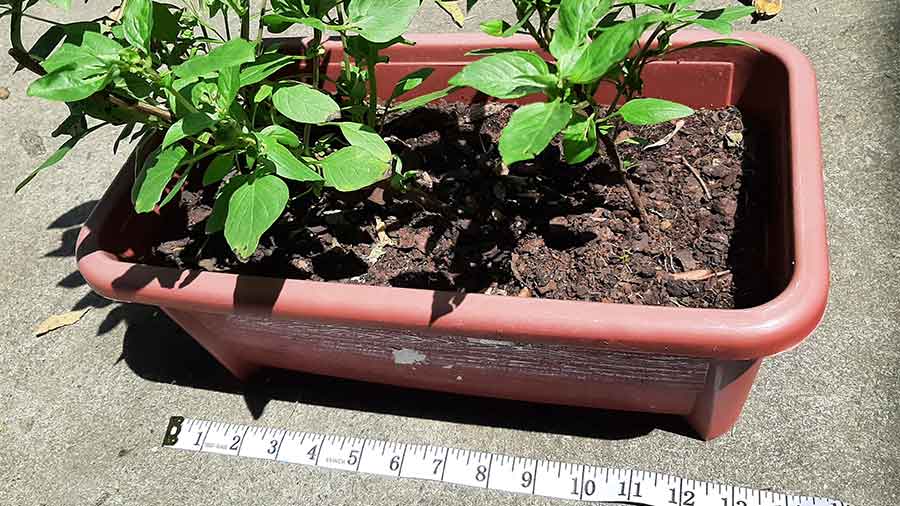Basil is a popular herb to grow at home. They can be grown in pots or grow bags. It is specially grown for its strong scent and fresh flavor. It has alternating broad, tender, and light green leaves. I often use the leaves for fresh basil pesto or any dish with tomato or cheese.
Before I planted basil in my garden, I searched for the ideal container size where it can really flourish. I found out from my research that you need to grow basil with a soil depth of at least 8 inches. One site even recommended the depth of the pot to be at least 18 inches. However, I didn’t have a container that fits the recommended size. So, I decided to use a smaller container that’s just lying around the house.
You can grow basil to at least 12 inches or 1 foot tall, by using a container that is at least 4 inches deep, 6 inches wide, and 6 inches long. This container has a soil volume of just 144 cubic inches.
The pot I’m using is actually 6 inches deep, but the soil is really just four inches deep.
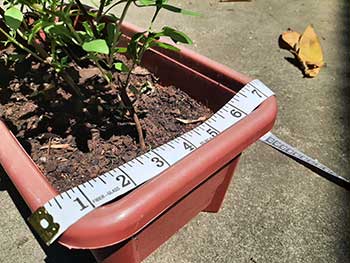
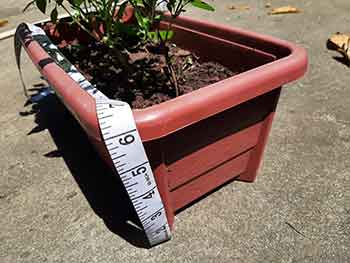
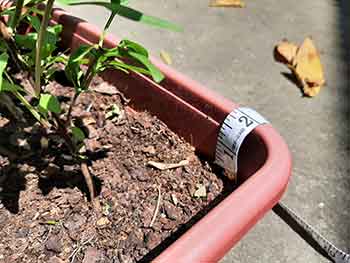
Basil Can Grow in Plastic Pots
For my container, I just use one made of cheap plastic with a color that makes it look like it is made up of clay. I like to use plastic ones because they can be transferred easily from one area to another. It is not as heavy as the terracotta pots.
Plus, some plastic pots have designs that can really make you think that it is terracotta. Plastic pots are also durable, at least for the ones I’m using. As long as they have the right-size drainage holes, I would recommend using plastic pots for planting basil.
Best Type of Soil to Use in Pots
Basil likes damp, moist soil. Make sure that the soil you use has good water retention qualities. At the same time, it has to be porous and rich in nutrients. Don’t use a sandy type of soil. In most cases, you can buy excellent quality potting soil online. This is to ensure that your plants really grow healthy.
Good porosity provides good air circulation and root development. If the soil is hard and dry, the roots cannot expand causing stunted growth. The loose texture is good for the roots in that it doesn’t have to spend more energy to spread to a larger area to look for nutrients.
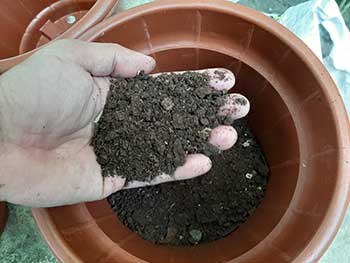
It also helps that there are no hard materials such as rocks or dead branches to stop the roots from spreading.
In my garden, I’m using my own potting mix with a ratio of 4-1-1-1. That is 4 cups garden soil, 1 cup coco peat, 1 cup wood chips, and 1 cup worm cast. This combination is a cheap, simple, and effective type of garden soil. This potting mix is what I put in small pots or containers.
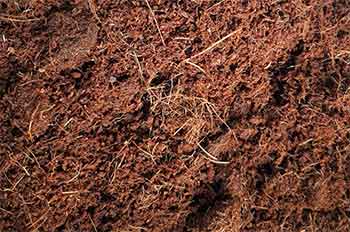
From my experience, this potting mix can be used in most plants. I have been using this to grow my herbs and vegetables.
There are other soil amendments that you can use. You may read about them in this article.
Nutrients to Add in Your Pots
The secret to making basil flourish is to provide it with a nitrogen-rich fertilizer. Nitrogen is needed by plants to produce chlorophyll, which makes the leaves green. It also makes the basil plant produce more leaves.
Chlorophyll, which is a green pigment, is present in all green plants and is responsible for the absorption of light to provide energy for photosynthesis. With a lack of nitrogen, they start to turn yellow.
To supply nitrogen to my basil plants, I use my own organic grass-clipping tea fertilizer. Aside from being easy to make, it also recycles my grass clippings that would have otherwise gone to waste. You can read about my organic grass clipping fertilizer here. Here are some more of my homemade organic fertilizers that you may want to try:
- Eggshell Fertilizer
- Banana Peel Fertilizer
- Carrot Peel Fertilizer
- Fermented Fish Fertilizer
- Fishtank Water Fertilizer
All of these are great to use in your garden. Most of the things you need are in fact, just kitchen wastes.
Does Basil Need Full Sun?
There are plants that I grow indoors. Some plants I put in the shade. But for my basil, I place them in an area where they receive sunlight for the entire day. I observe that they are getting about 8 hours of sunlight. This is from 8:00 in the morning, until 4:00 in the afternoon.
With this amount of sunlight, they have grown to about a foot tall in just 10 weeks after seed germination. However, just remember to keep the soil moist. Basil doesn’t tolerate dry soil.
When to Harvest Basil?
The basil you see here is grown from seed. I planted the seed on November 17, and it germinated after three days. I started harvesting the leaves on February 14 the following year when it was around 1 foot tall. But you can actually pick the leaves when it’s about 8 inches tall already.
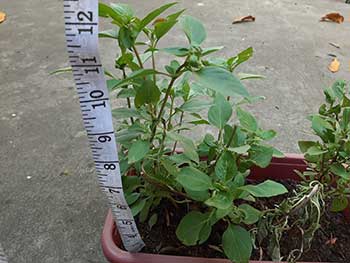
This is from the same basil that has been planted in only 4 inches of soil. I was really surprised that it grew this much after 3 months.
If you want to grow and harvest basil quickly, you can root it in water. I explained this process in another article. You can read about it here. In general, these are the steps in growing basil from cuttings:
- Cut the basil and put it in a wide-rim glass jar
- Choose rain or tap water that has been left overnight
- Prepare the basil cuttings by nipping off the lower leaves
- Put a handful of basil cuttings into the glass jar so that the stems are covered with water
- Don’t forget to change water at least once a week
- Allow the roots to grow a little more once they appear
- When roots start to come out, don’t change the water
- When a good root system has developed, pot the basil cuttings up
Summary
Basil can be grown in small and shallow containers, as I have experienced myself. As long as you have the right type of soil, nutrients, and sunlight, basil will grow vigorously. In no time, you can have fresh basil leaves in the kitchen, ready to be used in your favorite dish.


